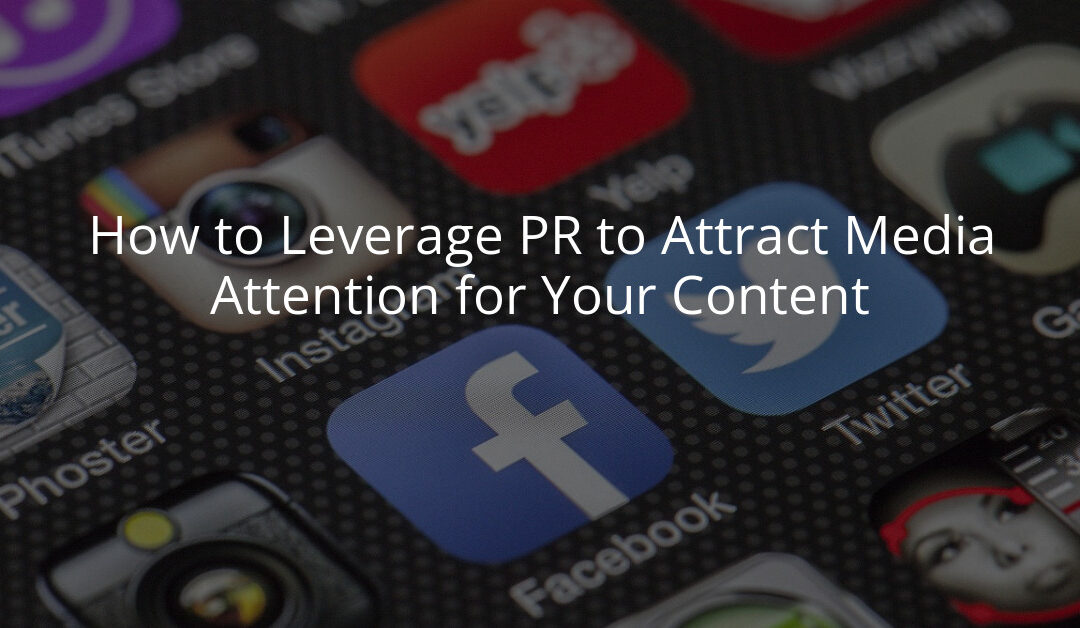How to Leverage PR to Attract Media Attention for Your Content
 In the digital landscape, new content emerges with the frequency of a heartbeat, therefore, capturing the spotlight can feel like an uphill battle. You’ve spent hours crafting valuable content, but without media attention, it remains hidden, much like a masterpiece gathering dust in an attic. The truth is, content that doesn’t reach the right audience is like a message in a bottle, tossed into a vast sea, with no guarantee of ever being found. So, how do you ensure that your message cuts through the noise and commands the attention it deserves?
In the digital landscape, new content emerges with the frequency of a heartbeat, therefore, capturing the spotlight can feel like an uphill battle. You’ve spent hours crafting valuable content, but without media attention, it remains hidden, much like a masterpiece gathering dust in an attic. The truth is, content that doesn’t reach the right audience is like a message in a bottle, tossed into a vast sea, with no guarantee of ever being found. So, how do you ensure that your message cuts through the noise and commands the attention it deserves?
The answer lies in leveraging public relations (PR) to amplify your content. Strategic PR helps secure media coverage, increases visibility, and boosts credibility. But it’s more than just sending out press releases; it’s about building relationships, crafting compelling narratives, and positioning your content as newsworthy. In this article, we’ll dive into three proven ways to use PR to attract media attention to your content—complete with examples of how these strategies can work in practice.
Related: Streamlining Blog Writing with ContentERP: A New Era of Effortless Content Creation
1. Craft a Compelling Story Around Your Content
 At the heart of every successful PR strategy is a story worth telling. Journalists and media outlets aren’t interested in promotional content for the sake of it—they’re drawn to stories that have depth, relevance, and human interest. To capture their attention, you need to find the unique angle that makes your content stand out.
At the heart of every successful PR strategy is a story worth telling. Journalists and media outlets aren’t interested in promotional content for the sake of it—they’re drawn to stories that have depth, relevance, and human interest. To capture their attention, you need to find the unique angle that makes your content stand out.
For example, say you’ve just published a groundbreaking report on sustainable business practices. Rather than simply promoting it as “New Report on Sustainability,” craft a story that taps into current trends or concerns. “How Sustainable Practices are Reshaping Corporate America Amid a Climate Crisis” tells a much more engaging and timely narrative. It connects your content to a broader issue that the media is already interested in.
Look at how Patagonia, the outdoor clothing company, consistently frames their sustainability efforts in the context of environmental activism. Instead of pushing product, they tell stories about their company’s commitment to ethical practices and environmental conservation. This storytelling approach has garnered widespread media coverage, not just for their products, but for their brand ethos.
By shaping a compelling narrative around your content, you increase the chances of journalists seeing it as relevant, timely, and valuable to their audience. Use this storytelling technique to give your content the hook it needs to grab the media’s attention.
2. Develop Strong Relationships with Journalists and Influencers
 Public relations, at its core, is about relationships. Building a network of journalists, bloggers, and influencers who trust your brand is key to securing media coverage. Instead of cold-pitching reporters, start by establishing authentic connections. Follow their work, engage with them on social media, and show genuine interest in their reporting. When you eventually pitch your content, you’re not just another name in their inbox—you’re a familiar face.
Public relations, at its core, is about relationships. Building a network of journalists, bloggers, and influencers who trust your brand is key to securing media coverage. Instead of cold-pitching reporters, start by establishing authentic connections. Follow their work, engage with them on social media, and show genuine interest in their reporting. When you eventually pitch your content, you’re not just another name in their inbox—you’re a familiar face.
Take the example of author and marketing expert Neil Patel. Patel regularly appears in Forbes, Entrepreneur, and The Huffington Post, not because he’s sending out generic press releases, but because he’s developed relationships with the editors and journalists at these outlets over time. He engages with their work, offers expert commentary, and ensures that when he has content to share, it’s relevant to their readers.
In practice, you might start by identifying a handful of journalists or influencers who cover topics relevant to your content. If you’ve created a piece about innovative education technology, find journalists who cover that beat. Reach out on Twitter, comment on their articles, or even send a brief, thoughtful email complimenting their work. When the time comes to pitch, these small steps will have laid the groundwork for a more receptive audience.
Additionally, ContentERP’s platform offers tools to help you identify key media contacts and manage outreach, ensuring your efforts are streamlined and organized.
3. Use Data and Insights to Offer Real Value
 In a world driven by information, data has power. Journalists are always on the lookout for fresh statistics, original research, and insightful trends that will grab their readers’ attention. By including data in your content, you give media outlets something to report on. Numbers, charts, and well-researched findings make your content not just interesting, but newsworthy.
In a world driven by information, data has power. Journalists are always on the lookout for fresh statistics, original research, and insightful trends that will grab their readers’ attention. By including data in your content, you give media outlets something to report on. Numbers, charts, and well-researched findings make your content not just interesting, but newsworthy.
Take the example of HubSpot, a company known for its inbound marketing software. HubSpot regularly publishes industry reports filled with valuable data and trends. Their “State of Marketing” report, for instance, provides key statistics that journalists and bloggers cite in their own content. HubSpot’s data has been featured in major publications because it’s timely, relevant, and authoritative—offering media outlets concrete information to enhance their stories.
If your content includes data or insights, make it easy for journalists to extract and use. Create infographics, offer downloadable charts, and provide clear takeaways that make your content an asset to their reporting. Highlight the most compelling statistics in your pitch to grab their attention.
For example, a blog post titled “The Future of Remote Work” could turn into a data-backed media pitch: “Our latest report reveals that 68% of businesses plan to continue remote work post-pandemic—here’s why that matters.” This gives journalists a headline, a data point, and a story all in one.
Turning Media Attention into a Catalyst for Growth
 Picture this: you’ve just stepped outside into a bustling city square, where the air is thick with energy and the hum of conversations swirls around you. Amidst the noise, someone calls your name. You turn, and suddenly, all eyes are on you—waiting, listening. This is what it feels like when your content finally captures the attention of the media. It’s not just visibility; it’s validation.
Picture this: you’ve just stepped outside into a bustling city square, where the air is thick with energy and the hum of conversations swirls around you. Amidst the noise, someone calls your name. You turn, and suddenly, all eyes are on you—waiting, listening. This is what it feels like when your content finally captures the attention of the media. It’s not just visibility; it’s validation.
But getting there requires intention, strategy, and patience. It’s about finding the story in your content that’s worth telling, building genuine relationships with those who hold the microphone, and providing data that adds weight to your message. With these three proven methods, you can elevate your content from background noise to headline news.
And remember, you don’t have to navigate the complexities of PR alone. ContentERP offers all the tools you need to craft compelling narratives, track outreach efforts, and position your content for maximum visibility. Sign up for ContentERP today, and take the first step toward transforming your content into a media magnet. Let your story be the one they can’t stop talking about.

